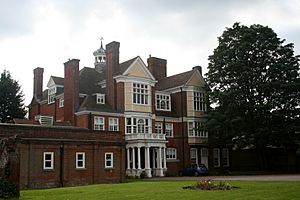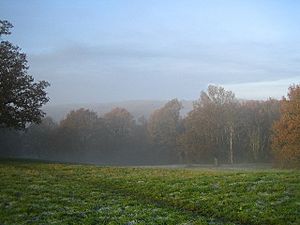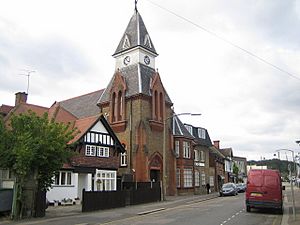Loughton facts for kids
Quick facts for kids Loughton |
|
|---|---|
 High Road, Loughton |
|
| Area | 15.30 km2 (5.91 sq mi) |
| Population | 33,353 (2021 census) |
| • Density | 2,180/km2 (5,600/sq mi) |
| OS grid reference | TQ422961 |
| • Charing Cross | 12 mi (19 km) SW |
| Civil parish |
|
| District | |
| Shire county | |
| Region | |
| Country | England |
| Sovereign state | United Kingdom |
| Post town | LOUGHTON |
| Postcode district | IG10 |
| Dialling code | 020 |
| Police | Essex |
| Fire | Essex |
| Ambulance | East of England |
| EU Parliament | East of England |
| UK Parliament |
|
| Website | http://www.loughton-tc.gov.uk |
Loughton is a town in Essex, England. It's part of the wider London area. The town is about 12 miles (19 km) north-east of Charing Cross in central London.
Loughton shares its borders with towns like Waltham Abbey, Theydon Bois, and Buckhurst Hill. A big part of Epping Forest is also within Loughton's parish. It's the most populated town in the Epping Forest district. In 2021, about 33,353 people lived here.
The town has three special areas that are protected for their history. There are also 56 buildings listed for their historical importance.
Contents
History of Loughton
The oldest known structure in Loughton is Loughton Camp. This is an Iron Age fort found in Epping Forest. It was built around 500 BC and was hidden for many centuries. People rediscovered it in 1872.
The first mentions of Loughton come from the Anglo-Saxons. They called it Lukintune, which meant "the farm of Luhha." Later, in 1062, King Edward the Confessor gave land here to Harold Godwinson. The town is also mentioned in the Domesday Book of 1086 as Lochintuna.
Loughton was a small village until the 1600s. Then, a main road was built through the forest. This road became a key route from London to Cambridge and East Anglia. Loughton grew into an important stop with many coaching inns.
One important house was Loughton Hall. Mary Tudor owned it briefly before she became Queen in 1553. Later, the Wroth family lived there. They hosted famous writers like Ben Jonson. The hall was rebuilt in 1878. Today, it's a care home and a listed building.
The town grew a lot, often using parts of the forest. Building towards the River Roding was hard because of floods. But people built more homes into the forest areas.
The arrival of the railway helped Loughton grow even more. The first train came in 1856. In 1948, the line became part of the Central line of the London Underground.
In Victorian and Edwardian times, Loughton was a popular place for artists and scientists. Many famous people who lived here were also social reformers. After World War II, new housing estates were built. These were for London families whose homes were damaged by the war.
The former printing works for the Bank of England are in Debden's industrial area. Now, De La Rue prints banknotes there. Other companies like Clinton Cards and Higgins Group also have their main offices here.
Loughton has been featured in TV shows. It was in Essex Wives, a show about wealthy people in Essex. This show helped make the area known as a "golden triangle." It attracts famous people like footballers and TV stars. The town has also been a setting for The Only Way is Essex.
Geography of Loughton
Loughton is bordered by Epping Forest to the west. To the east, it has the Roding river valley. After 1878, new laws stopped building into the forest. This meant the town mostly grew by filling in empty spaces. New homes were built north and south of the old town. The area near the Roding river often floods. So, most of that land is a nature reserve or open parkland. The M11 motorway is built on raised banks to avoid floods.
The highest parts of Loughton are near the forest's edge. From places like Baldwins Hill, you can see views of London and beyond. Loughton Brook flows through the town. It starts in Epping Forest and ends in the Roding river.
Loughton has several unique areas:
- Old Loughton is the original village around Loughton High Road.
- Debden is a large area to the north-east. It was built after World War II. It provided homes for people from London. Jessel Green is a big open space in Debden.
- Debden Green is a small village with an old green. Debden House here is a learning and conference center.
- Goldings Manor is a modern estate with large houses. It was built where a mansion once stood.
- Great Woodcote Park is a new housing estate in the south.
- Little Cornwall is a hilly area near Epping Forest. It has steep hills and unique houses.
- Roding Estate or South Loughton is south-east of the Underground line. Most homes here were built between the World Wars.
Population and People
In 2021, Loughton had a population of 33,353 people. This was an increase from 31,106 in 2011.
The 2021 census showed that 73.5% of the people in Loughton were White British. In 2016, Loughton was ranked as one of the best towns in the country for people from different backgrounds living together.
Public Services
Before 2000, the Metropolitan Police handled policing in Loughton. Since April 1, 2000, the Essex Police has been responsible.
Loughton also has a fire station. It is run by the Essex County Fire and Rescue Service.
Culture and Arts in Loughton
Drama and Theatre
Loughton is home to the East 15 Acting School. This school grew from the famous Joan Littlewood's Theatre Workshop. The school is now part of the University of Essex. It has the Corbett Theatre, where plays are often performed. The theatre is named after actor Harry H. Corbett. The building itself is an old medieval barn that was moved here.
Many actors have lived in Loughton. Jack Watling and his son Giles Watling lived at Alderton Hall. Actor Ken Campbell lived in Baldwins Hill. A special blue plaque honors him there. Comedian Alan Davies grew up in Loughton. Actress Jane Carr was born here.
Amateur plays are often put on at Lopping Hall. The Loughton Amateur Dramatic Society performs here. Lopping Hall opened in 1884. It was built to make up for villagers losing their right to collect wood in Epping Forest. The hall was once Loughton's town hall.
Music Scene
Loughton has a history of classical music. Today, concerts are held at Loughton Methodist Church. This church also hosts the annual Loughton Youth Music Festival. St. John's Church choir goes on tours and hosts famous musicians.
The town has some rock and pop music connections too. Mark Knopfler from Dire Straits used to teach at Loughton College. The Wake Arms pub (now gone) was a rock music venue. Bands like Black Sabbath and Deep Purple played there. Ray Dorset of Mungo Jerry won a music contest in Loughton early in his career.
The Roding Players is an amateur orchestra that practices in Loughton. The Epping Forest Brass Band also performs regularly. Loughton has its own music academy, founded in 2001. The Loughton Folk Club meets weekly.
Opera and Dance
In the 1930s, Loughton had outdoor opera shows called Pollards Operas. The Loughton Operatic Society, started in 1894, still puts on musicals and operas at Lopping Hall.
Epping Forest Arts sometimes puts on dance shows in Loughton. Harlow Ballet also recruits dancers from the area.
Visual Arts
Many famous artists have lived in Loughton. Sculptor and painter Sir Jacob Epstein lived here for many years. Sculptor Elsa Fraenkel also lived in the town. Artist John Strevens lived in Lower Park Road. Walter Spradbury, known for his London Transport posters, lived nearby.
William Lakin Turner painted in Loughton in the 1890s. Artists William Brown Macdougall and his wife Margaret Armour lived here too.
Cinema and Films
Early movies were shown at Lopping Hall. A special Loughton Cinema opened in 1928. It could seat 847 people. After it closed, the Loughton Film Society started in 2010 to bring movies back.
George Pearson, an early British film director, was a headmaster in Loughton. Film actor Charles Ashton also lived here.
Some films have been set in Loughton. The 2001 TV movie Hot Money was based on real events at the Bank of England printing works in Loughton.
Literature and Books
Loughton has many links to famous writers. Lady Mary Wroth lived at Loughton Hall. She turned it into a center for writers in the 1600s. Ben Jonson visited often. Lady Mary wrote Urania, which is thought to be the first full-length English novel by a woman.
Anthony Trollope set part of his novel Phineas Finn in a made-up Loughton. Robert Hunter, who wrote encyclopedias, built a house here. William Wymark Jacobs, author of The Monkey's Paw, lived in Loughton. He also wrote stories set in 'Claybury', which was based on Loughton. Rudyard Kipling stayed at Goldings Hill Farm as a child.
Arthur Morrison, known for his novels about London, lived in Loughton. Children's author Hesba Stretton (Sarah Smith) lived here. Her books helped people understand the lives of poor children in Victorian London.
Ruth Rendell, a famous crime writer, went to school in Loughton. She also worked as a journalist here. Some of her books are set in Epping Forest. The area called 'Little Cornwall' in Loughton got its name from her novel The Face of Trespass.
Many poets have lived in Loughton. These include Sarah Flower Adams, Sarah Catherine Martin (who wrote "Old Mother Hubbard"), and William Sotheby. Alfred, Lord Tennyson lived nearby in High Beach. John Clare and Edward Thomas also lived in High Beach. Poet George Barker was born in Loughton.
T. E. Lawrence (Lawrence of Arabia) bought land near Loughton. He built a hut there, which was later moved to The Warren in Loughton.
Sports and Fun
Many sports stars live in Loughton. These include cricketers James Foster and Ryan ten Doeschate. Footballer Harry Kane also lives here.
Loughton Leisure Centre has a swimming pool and fitness facilities.
- Athletics: Loughton Athletic Club competes in track and field events.
- Bowls: Loughton Bowls Club has its ground at Eleven Acre Rise.
- Cricket: Loughton Cricket Club started in 1879. Its ground is an important open space. The South Loughton Cricket Club started in 1938.
- Fencing: Loughton Fencing Club meets at Debden Park High School.
- Football: Many local football teams play at Willingale Road and Roding Valley. Ron Greenwood, who managed the England football team, lived in Loughton.
- Golf: Loughton Golf Club has a 9-hole course. Many other golf courses are nearby.
- Mountain-biking: You can mountain bike in most of Epping Forest.
- Orienteering and Rambling: Long walking paths go through Loughton. The Chigwell & Epping Forest Orienteering Club is active here. The West Essex Ramblers club also organizes walks.
- Speedway: The first speedway event near Loughton was in 1928.
- Swimming: Epping Forest District Swimming Club meets at Loughton Leisure Centre.
- Tennis: The Avenue Lawn Tennis Club has four courts. The Town Council also has courts at Roding Valley.
- Taekwondo: Loughton Taekwondo meets at Debden Park High School. Their instructor, Chan Sau, won a gold medal at the Commonwealth Games.
- Karate: The Loughton Karate Club meets at The Lopping Hall.
Getting Around
Trains and Underground
Loughton has two London Underground stations: Loughton tube station and Debden tube station. Both are on the Central line. This line connects Loughton to central London and other parts of east and west London.
The railway line first opened in 1856. It became part of the Central line in 1949.
Buses
Bus services in Loughton are part of London Buses. They connect the town to nearby places like Buckhurst Hill, Chingford, and Woodford.
Roads
The M11 motorway runs along Loughton's eastern side. It connects Cambridge to London. You can get on the M11 from Loughton at junction 5 if you are going south. However, you cannot get on going north or exit coming south. The M11 was built in the 1970s and 1980s.
Education in Loughton
Loughton has many schools for different age groups.
Primary Schools
- Alderton Infant and Junior Schools
- Hereward Primary School
- Staples Road Primary School
- Thomas Willingale School
- White Bridge Primary School
- St John Fisher Catholic Primary School
Secondary Schools
- Davenant Foundation School
- Debden Park High School
- Roding Valley High School
Faith Schools
- St. John Fisher Catholic Primary School is a Catholic school.
- Davenant Foundation School is a Christian school. It started in London in 1680 and moved to Loughton in 1965.
Special Schools
- Oak View School
- Woodcroft School
Independent Schools
- Oaklands School (for ages 2½–11)
Colleges
- Debden House is a college for adult education.
- East 15 Acting School is part of the University of Essex.
- Epping Forest College is a college for further education.
- LMAT is a music academy.
Famous People from Loughton
Many notable people have lived in or are connected to Loughton:
- Thomas Willingale (1799–1870) helped save Epping Forest.
- James Cubitt (1836–1912) was an architect known for designing chapels.
- Everard Calthrop (1857–1927) was a railway engineer and parachute inventor.
- Sir Leonard Erskine Hill (1866–1952) was a physiologist.
- Dr Millais Culpin (1874–1953) was a surgeon and a pioneer in psychiatry.
- Sir Frank Baines (1877–1933) was a government architect.
- Major Greenwood (1880–1949) was an epidemiologist and statistician.
- Sidney Godley (1889–1957) was the first private soldier to receive the Victoria Cross in World War I. He is buried in Loughton Cemetery.
- Sir Hugh Cairns (1896–1952) was a neurosurgeon. He supported the use of crash helmets.
- Sir Austin "Tony" Bradford Hill (1897–1991) was an epidemiologist and statistician.
- Captain Richard Been Stannard (1902-1977) received the first Victoria Cross for the Royal Naval Reserve in World War II.
- Sir William Addison (1905–1992) was a historian and author.
- Commander Rupert Brabner (1911–1945) was a Member of Parliament and a World War II pilot.
- James Edgar "Johnnie" Johnson (1915–2001) was a famous RAF fighter pilot.
- Len Murray (1922–2004) was a leader of the Trades Union Congress. He lived in Loughton for over 50 years.
- Matt Johnson (born 1961) is the frontman of the band the The.
- Alan Davies (born 1966) is a comedian and actor.
- Joanna Forest (born 1977) is a classical singer.
- Richard Hounslow (born 1981) won a silver medal in canoeing at the 2012 Summer Olympics.
- Gary Hooper (born 1988) is a footballer for Glasgow Celtic.
- Diana Kennedy (1923–2022) was a food writer. A blue plaque honors her at her former home in Loughton.
Images for kids
See also
 In Spanish: Loughton para niños
In Spanish: Loughton para niños





